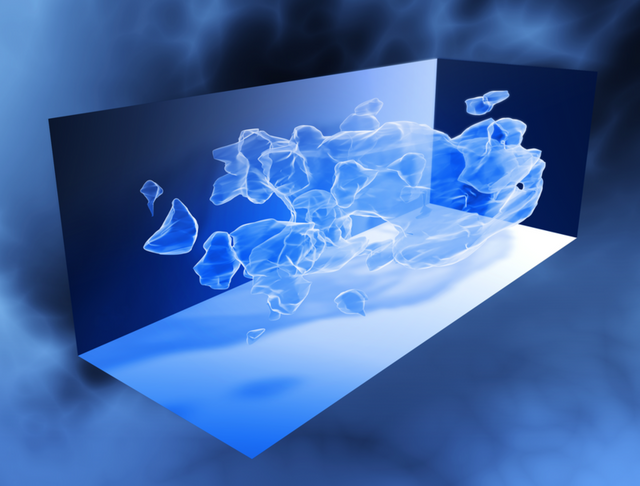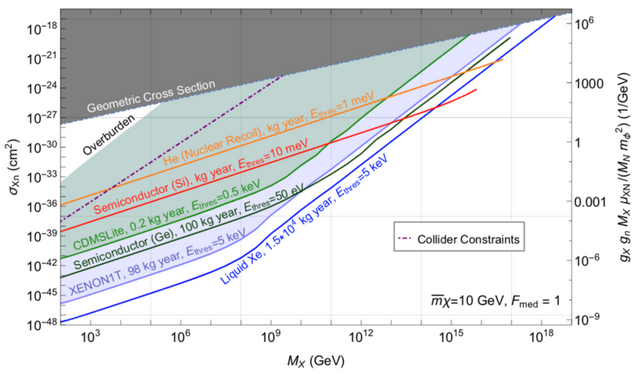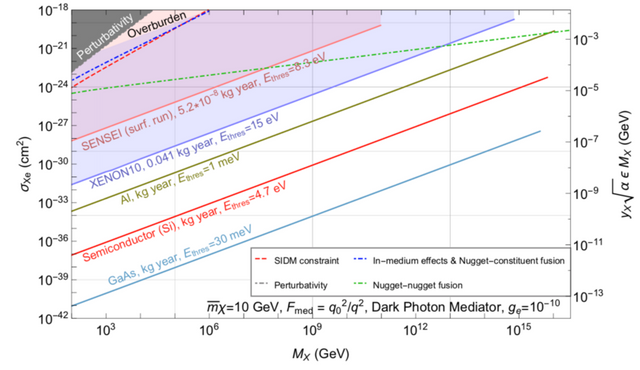Detecting nuggets of dark matter
Dark matter studies are today very multidisciplinary and lie at the interface of collider physics, astrophysics and cosmology.

[image credits: NASA/ESA (public domain)]
The indirect convincing hints for dark matter have indeed sparked a huge experimental endeavour and many subsequent theory works. However, the nature of dark matter remains elusive and there is no clear indication of what dark matter could be (or could not be).
Among all dark matter models that explain the lack of observation lies the idea of nuggets of asymmetric dark matter which I have read about a few weeks ago. The authors explained the motivation behind the idea of elementary dark particles forming huge composite dark systems and investigated how to detect (and thus discover) them in experiments.
The present post extents a post I wrote more than a year ago, as I focus this time on the detection of dark nuggets. I will however make this post self-consistent and explain all the concepts.
Dark matter in a nutshell

[image credits: geralt (Pixabay)]
Dark matter was initially introduced to explain why, at large distance from the galactic centers, the stars were moving faster than what Newtonian gravity was predicting.
Fritz Zwicky proposed that some invisible mass was present outside the galactic core, and that the corresponding gravitational effects were making the stars rotating faster.
Dark matter was hence born to restore agreement between theory and observations for the motion of stars in galaxies. But that is not the entire story.
The measurements of the small variations in the cosmic microwave background, the fossil radiation left over from the big bang, can only be explained with dark matter. The distortion of spacetime that is required to explain the bending of light (i.e., gravitational lensing) requires dark matter, and an explanation for the formation of the galaxies necessitates a bunch of dark matter too.
Dark matter is just everywhere (and there are actually more examples that I did not listed).
Dark matter is nevertheless very weakly interacting, so that its interactions with normal matter are rare. But the interaction rate is non-zero, so that if we wait long enough with a large enough detector, we may measure the recoil induced by a dark matter particle hitting normal matter.
This idea is at the basis of all dark matter direct detection experiments.
Dark nuggets

[image credits: NASA (public domain)]
Dark nuggets arise from particle physics models featuring a dark sector, i.e. an entire part of the model that is dark and lives its own life almost independently of the Standard Model sector (i.e., the sector of normal matter).
The dark sector generally contains elementary particles that interact with each other through dark interactions.
If the dark force is strong and attractive, composite systems of hundreds of billions of billions of (1020) dark particles, the so-called dark nuggets, can be formed. The mass of their elementary constituents and the way in which they collectively behave fix all nugget properties, and in particular their size.
The potential detection of those dark nuggets is the question that has been addressed in the research article which this post is about. These capabilities depend on a mediator whose properties allow for the rare interactions of dark matter with the Standard Model, and on the nugget size and density.
Detecting dark nuggets
As said above, direct dark matter detection rely on the measurement of the visible recoil induced by a dark matter particle reaching Earth and hitting one of the detector constituents.
We first focus on high-exposure experiments, where exposure accounts both for the detector size and the detection time. These experiments target the observation of the recoil of one of the atomic nucleus that is part of the detector material, and they feature a threshold that is this quite high (nuclear recoil are more energetic than electronic ones).
An example of such experiments, whose material consists for instance of noble liquid, could be the currently running XENON experiment in Italy.

[image credits: arXiv]
The figure above illustrates the coverage of the model parameter space, by running and planned high-exposure experiments, for the case of heavy mediators. One can see that those experiments cover the parameter space quite nicely, especially for lighter nuggets (the left part of the figure).
Moreover, the article also shows that more compact nuggets are better covered than less dense ones, and that lighter mediators (connected to long-range forces) makes the life of these experiments complicated (smaller thresholds are in order to get better signals).
For these long-range mediators, lower-threshold experiments are in order, relying on electronic recoils instead of nuclear recoil. These experiments however feature a smaller exposure time. An example of such experiment is the Sensei experiment that currently runs in the US.

[image credits: arXiv ]
In the above figure (focusing on long-range mediators), we can indeed see that the model parameter space will be nicely covered by future low-exposure low-threshold experiments. The article also shows that these experiments probe better less dense nuggets, and that they lack sensitivity for heavy mediators compared with the high-exposure case.
Take-home message
In this article, I discussed the problematics of dark matter and consider models in which dark particles form very large composite objects called dark nuggets.
I have summarized the results of a recent research article in which the sensitivity of current and future dark matter direct detection experiments (i.e., experiments probing dark matter through the recoil of normal matter when a dark object hits a detector) is studied.
The dark future is promising and actually quite bright, especially either when the particle mediating the interactions of the dark nuggets with normal matter is heavy and the nuggets are light and compact, or for a long-range dark nugget interactions with normal matter and not so dense nuggets.
SteemSTEM
Make sure to follow SteemSTEM on steemstem.io, Steemit, Facebook, Twitter and Instagram to always be up-to-date on our latest news and ideas. Please also consider to support the project by delegating to @steemstem for a ROI of 65% of our curation rewards (quick delegation links: 50SP | 100SP | 500SP | 1000SP | 5000SP | 10000SP).
Cool stuff. This might be a dumb question, but if we eventually detect dark matter with an experiment or observation method, does the dark matter then become regular matter? Or will it always be classified as dark matter due to it's physical properties?
Thanks for passing by!
Dark matter is called dark matter because it does not interact electromagnetically (or via quantum chromodynamics) and it interacts gravitationally. Assuming we discover it in a close future, it will still be dark matter as the discovery won't change the properties that make us to call it dark matter.
As I was reading this reply a question struck me:
How can a dark matter particle hit the detector if it interacts only gravitationally?
As far as I understand, when regular objects (such as balls) hit one another it is mediated by molecular forces of elecromagnetic nature. And neutrino detectors rely on the weak force. If "hitting" means gravitational interaction, wouldn't it be too weak to be detected? But otherwise, it seems that dark matter would go through regular matter completely unnoticed as the most parts of neutrinos do. There will be no hitting. Am I missing something?
In this case, it can't and the way that is currently followed to detect dark matter is bounded to fail. There are good hopes that dark matter gets extra interaction on top of the gravitational ones (from early universe considerations). But again, this is an assumption.
Not necessarily the weak force for dark matter as dark matter may possess its own interactions (that are different from any interaction we know). The magnitude of these interactions has to be weakish (as we didn't detect dark matter so far), but on the other hand, we have models in which dark matter is strongly interaction (like in this post).
Yes, I mentioned the weak force only as an example to show that there should be some fundamental force that "performs the hitting". Thank you for your answer! It is now clearer to me.
BTW, what do you think about negative mass particles as dark matter (and dark energy) candidates? Is it a viable idea?
For the moment, I don't think anything about this idea... because I didn't read the paper yet. I will do that later today or tomorrow and then comment your post.
Has there been evidence of dark nuggets somewhere near our solar system? As in, possibly reachable by probes?
No there is no evidence of them (so far). However, the model is at the same time not excluded, so that we must stay pragmatic and consider the option on the same footings as other options.
So much of what you describe goes way, way over my head, but your explanation of indirect proof reminds me of the early days in the study of radioactivity, when Roentgen, Becquerel and Curie operated literally in the dark, but noticed the effects of the rays and knew they were onto something. This was long (actually, not that long) before the structure of the atom was described and the properties of radioactive elements understood.
I always get something out of a blog that's beyond me :)
We are indeed totally in the dark today. There are phenomena that need to be explained, but we can't find any explanation that is favored by data. On the other hand, there is none of the proposed explanations that are excluded at the same time. in short, we are living an exciting period :)
This is actually my first time of hearing about dark nugget. I'm glad I read this piece.
I to want ask a question (maybe unrelated). Since the mirror opposite of matter is antimatter, would I be right to infer that the opposite of dark matter is anti dark matter? Does anti dark matter even exist?
Hope I'm not asking a stupid question?
The question is by far not stupid at all. The nature of dark matter is elusive so that every single option is something to consider (at leat until we don't get any clearer hint about dark matter). There are dark matter model where the dark matter particle is its own antiparticle, and there are dark matter models where anti-dark-matter exists.
The answer to your question is thus yes and no at the same time :D
Are there theories that dark matter particles are actually microscopic black holes? Can such theories be considered seriously?
A black hole seems to be a good candidate for a dark matter particle. It does not emit light and is likely to interact only gravitationally (i. e. unlikely to have a (big) electric charge).
Naively I would have said no, because micro black holes evaporates (and a viable dark matter candidate must be stable). After checking, there is actually one theory that proposes this idea. The research paper is available here. I however haven't read it so that I can't tell.
Primordial black holes are in contrast good candidates to explain dark matter, and this hypothesis could be challenge by the future experiments hunting for gravitational waves.
Aha, primordial black holes then. Aren't they too big for dark matter, which supposedly should be uniformly distributed in the Universe?
Dark matter is not uniformly distributed in t he universe. There are areas where a larger density is needed, and vice versa. The model is pretty constrained, especially since the discovery of gravitational waves, but it is not excluded. And as anything that is not excluded is alive ... :)
Will there be any relationship between matter and energy for this case?
https://journals.aps.org/prl/abstract/10.1103/PhysRevLett.121.261301
I am sorry, but I am not sure to understand the question. Dark matter has to account for a significant fraction of the energy budget of the universe, so that I would tend to answer 'yes' to your question.
By the way, the article you are referring to has nothing to do with the topic addressed is this post, as this consists in a string theory model for cosmology.
OKI OKI Merci.
SALUDOS DESDE VENEZUELA
SALUTATIONS DU VENEZUELA
Greetings from Venezuela
Awwww, nuggets. I don't know why but that word is adorable to me and surprisingly enough even more adorable in this context. Black nuggets, from a boy-bend name to a culinary recipe, it can be used everywhere :D Joking aside, you really made a great and easy to read post. I am becoming a bigger fan with each day and really enjoy reading your stuff
Please don't eat dark chicken nuggets! I don't know all details, but I am fully sure this may hurt you :D
Thanks for passing by, by the way, and for the nice comment :)
Congratulations @lemouth! You have completed the following achievement on the Steem blockchain and have been rewarded with new badge(s) :
Click here to view your Board
If you no longer want to receive notifications, reply to this comment with the word
STOPDo not miss the last post from @steemitboard:
Hi @lemouth!
Your post was upvoted by Utopian.io in cooperation with @steemstem - supporting knowledge, innovation and technological advancement on the Steem Blockchain.
Contribute to Open Source with utopian.io
Learn how to contribute on our website and join the new open source economy.
Want to chat? Join the Utopian Community on Discord https://discord.gg/h52nFrV
SALUDOS DESDE VENEZUELA
SALUTATIONS DU VENEZUELA
Greetings from Venezuela
A dark lizard? :D